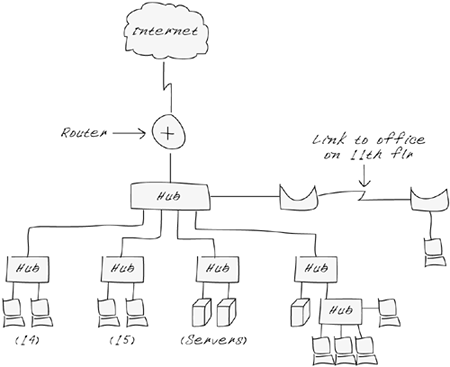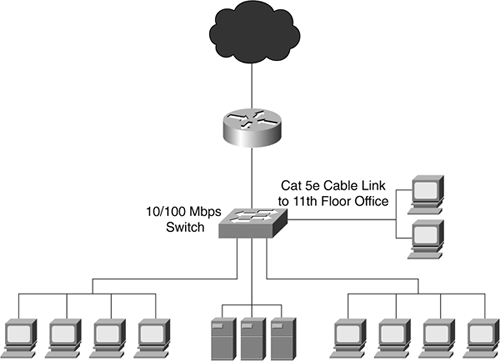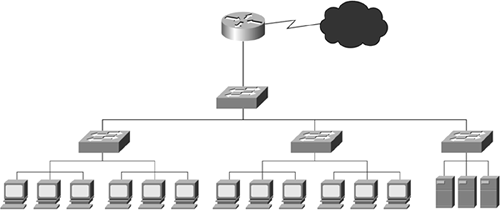Small Switch-Based Networks
You were just hired to manage a network for a small company and arrive on the scene to find the current network a mess. You have daisy-chained hubs everywhere, people keep moving around, and your users are complaining that the network is slow. You've locked yourself in a room with a whiteboard to diagram your network, and you've come up with what is shown in Figure 12-9.
Figure 12-9. Whiteboard Drawing of Your Current Network

When looking at an existing network or designing a new network, remember that it's best to break it down into pieces. Take a look at what you have here:
An Internet connection and a router.
Hanging off that router is a hub with five connections.
Four of these connections are going to other hubs, and one of those hubs has another hub hanging off it with additional attached workstations.
The fifth connection is going to another floor in the building and is connected with a bridge.
You have four groups of users spread throughout the office: a sales team, a marketing team, an engineering team, and a human resources team. Each user community has unique demands on the network in terms of bandwidth and availability. For example, the sales team needs the network so that they can communicate via e-mail with their clients, and the engineering team needs the network so that they can test how their new applications operate across the Internet.
At this point it might be worthwhile deploying a switch and segmenting the network into more manageable pieces, such as giving the sales and engineering teams their own segments so that they are not contending with each other for the network bandwidth. Because hubs are used everywhere, your current network is one large collision domain. This is not a bad thing, unless you have users complaining. You can improve network performance by implementing a small switch, as illustrated in Figure 12-10.
Figure 12-10. Small Switch-Based Network

To implement the configuration shown in Figure 12-10, you bought a small switch, with 48 or 96 ports on it (because you don't have many users, but you want to leave some room to grow). You removed all the bridges and hubs from the network and connected everyone directly to the switch. You thought about using VLANs here but have decided to wait and see whether VLANs are necessary?because this is still a small network (fewer than 50 ports are being used), but you are going to keep an eye on things and see whether performance has improved and if the user complaints drop.
The small switch design, illustrated in Figure 12-11, shows another option in which multiple switches are used to create a hierarchical design.
Figure 12-11. Small Hierarchical Switch-Based Network

This switch-based hierarchical design enables you to better manage your network by controlling the flow of traffic rather than using hubs, which repeat all traffic to all users. Using switches in this hierarchical design also provides you more usable ports for end users than hubs provide.






